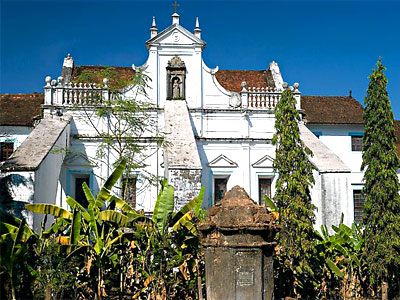 The Church and the Convent of St. Monica is one the oldest churches of Goa. It is situated beside the Chapel of St. Anthony and facing north on Monte Santo. Sanctioned in 1598 and the church was erected by the Archbishop Dom Frei Alexio de Menezes. He was also the then Governor of Portuguese India on July 2nd 1606. The construction of the church was completed in 1627. The rules of the monastery framed by the Archbishop were modelled on those of St. Augustine and were approved by Pope Paul V. The convent known as the Royal Monastery of Santa Monica was the first nunnery of the East. This building was destroyed in fire in 1636, and was rebuilt in the following year. This church and convent is believed to be the first nunnery built in the east.
The Church and the Convent of St. Monica is one the oldest churches of Goa. It is situated beside the Chapel of St. Anthony and facing north on Monte Santo. Sanctioned in 1598 and the church was erected by the Archbishop Dom Frei Alexio de Menezes. He was also the then Governor of Portuguese India on July 2nd 1606. The construction of the church was completed in 1627. The rules of the monastery framed by the Archbishop were modelled on those of St. Augustine and were approved by Pope Paul V. The convent known as the Royal Monastery of Santa Monica was the first nunnery of the East. This building was destroyed in fire in 1636, and was rebuilt in the following year. This church and convent is believed to be the first nunnery built in the east.
This convent was constructed for the nuns. It was large enough for the accommodation of about hundred nuns who were considered as the daughters of St. Monica. The church also had provisions for the widows who were willing to devote themselves to the service of Goa. The nunnery also helped the women give shelter during the absence of their husbands.
Architecture of Church and Convent of St. Monica
The Church and Convent of St. Monica is combination of different architectural styles.
The huge three-storied building made in laterite is circled on its side by a huge enclosure. The building has numerous cells and halls with sheltered verandas. The vaulted ceilings are well decorated with floral decorations and some episodes from the Holy Bible are also painted.
The huge gardens of the convent bore aromatic plants and beautiful flowers. In the nearby orchards some of the best fruits grew while the kitchen garden produced all kinds of vegetables. The wells constructed helped in the supply of regular water for consumption as well as irrigation. The church St. Monica is conjoined to the convent to the south. The external architecture of the church is a combination of the Tuscan, Corinthian and composite style while the internal architecture is a blend of composite and Doric styles. The length of the church is 175 feet and breadth 36 feet.
The facade of the church bears a statue of Santa Monica and the symbol of the Holy Ghost on the top. The central area of the church is divided into two parts. The first part comprises of the main part of the church with two side altars. One on the right side is dedicated to Divine Jesus and the one on the left to Virgins Africanas. The main altar has the image of Santa Monica, mother of St. Augustine, to whom the convent and the church is dedicated.
In the tribune that surmounts to the altar, raises the famous "Miraculous Cross", 108" high which is held in great veneration. The convent was closed as a nunnery since its last sister died in 1885 and was rebuilt into a church in 1968. The church houses the Theological Center of the Matar Dei institute which has been a centre for higher education for nuns from all over the world. The institute was inaugurated on June 5th 1964.











